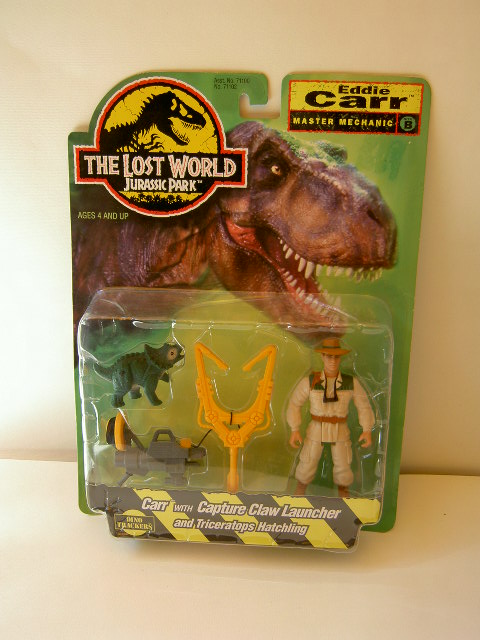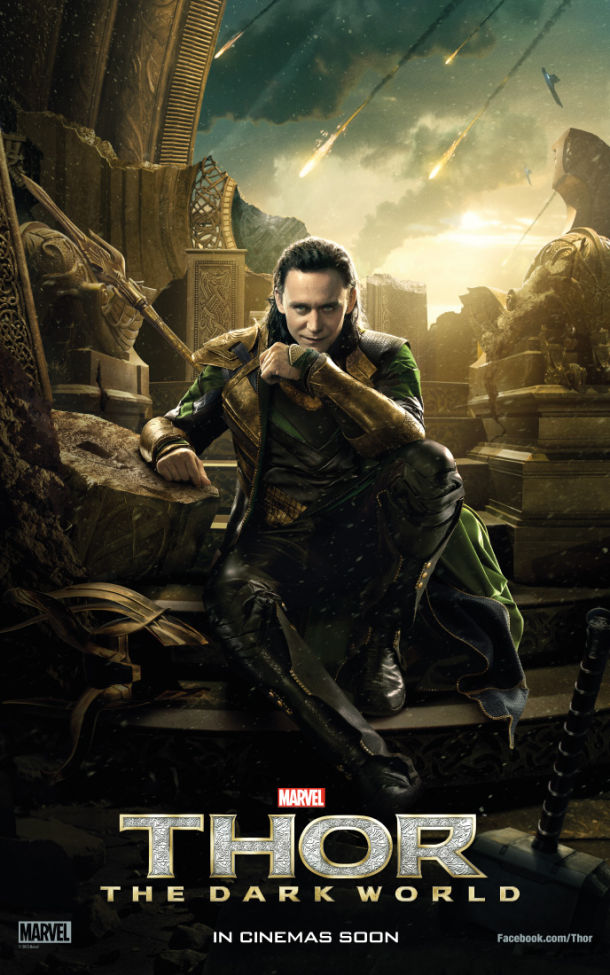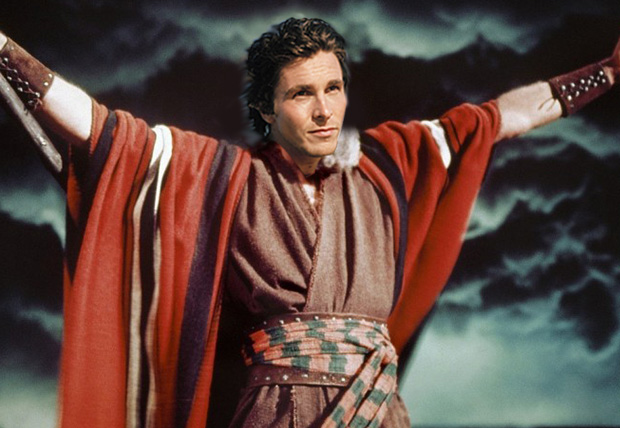Hoofdstuk
3: Religie in de terrestrial creature
en altered human
subgenres
Hoewel
religie zeker aanwezig is in zowel het ‘terrestrial
creature’ als het ‘altered
human’ subgenre, zal ik beide genres hier
samen kort behandelen. De reden hiervoor is dat religie in beide
genres in grote lijnen op dezelfde manier naar voren komt en een
vergelijkbare boodschap beschrijft. Als geheel is zij minder
prominent aanwezig dan in de ‘man into
space’ en ‘alien
invasion’ subgenres. Desondanks, religie is
wel degelijk aan te treffen in beide subgenres, waardoor een
beschrijving van haar rol hierin niet in dit paper mag ontbreken.

Het
met religie verbonden thema dat als rode draad door beide subgenres
loopt is het spelen of rommelen van de mens met machten die buiten
zijn begrip en controle liggen, vaak letterlijk aangeduid (zowel in
de films zelf als in dat wat over de films geschreven is) als
‘playing God’. De
wetenschap bedoelt het niet slecht en is slechts uit op nieuwe
uitvindingen en inzichten die het leven van de mensheid er beter op
maken: men is zich bewust van het gevaar, maar acht het de moeite
waard het risico te nemen ten bate van de vooruitgang. Zoals
gesteld wordt in Monster
on the Campus (USA:
Jack Arnold, 1958):
Man
can use his knowledge to destroy
all spiritual values
and reduce the race to bestiality. Or he can use his knowledge to
increase
his understanding
to a point far beyond anything now imaginable. [my emphasis]
Maar
door gebrek aan inzicht en vooral overmoed lopen dergelijke
experimenten uit de hand, met rampzalige gevolgen. De termen die de
subgenres volgens mijn benaming aanduiden reflecteren deze gevolgen:
in het ‘terrestrial
creature’
subgenre wordt Amerika bedreigd door reusachtige monsters, in het
‘altered
human’
subgenre wordt de mens zelf vervormd. In beide gevallen wordt
frequent gesproken van een straf van God, of in ieder geval een
hogere macht, voor het rommelen met krachten die alleen Hij beheerst
en mag beheersen: ‘divine
retribution’,
noemt John Brosnan het.
De mens leert zijn les: aan het eind van bijna elke film uit deze
subgenres wordt opgemerkt dat men arrogant en onverantwoordelijk was
om met goddelijke machten te rotzooien. Zulke machten, van het atoom
of van de natuur, hebben opnieuw bewezen niet te bedwingen te zijn:
eens te meer beseft Amerika dit.
‘Humanity acknowledges that it has been arrogant in presuming upon
its role in the cosmos’, zo omschrijft Lucanio dit besef, wat hij
aanstipt als eindpunt in een vastliggende narratieve formule die
welhaast constant gebruikt werd in het ‘terrestrial
creature’
subgenre.
Het
voornaamste verschil tussen beide subgenres ligt hem in de schaal van
het experiment en haar gevolgen. In het ‘terrestrial
creature’
subgenre is deze schaal collectief: de omvang van het experiment en
de daarbij gebruikte krachten (meestal verbonden met de atoom- of
waterstofbom) genereert een kolossale ramp – op te vatten als zowel
de grootte van de monsters als de omvang van de door hen aangerichte
ravage – die hele steden verwoest en duizenden bedreigt
(voorbeelden: It
Came from Beneath the Sea
(USA: Robert Gordon, 1955), The
Deadly Mantis
(USA: Nathan Juran, 1957)). Vivian
Sobchack citeert Joe Kane, die spreekt van het ‘Bestial
Invocation theme’:
‘…the creatures are seen as instruments of punishment for nuclear
misuse’.
Hoewel
niet de hele samenleving direct verantwoordelijk is ligt de schuld
bij het collectief: de geleerden in deze films werken nooit alleen,
maar altijd in groepsverband in dienst van de regering. Het mandaat
voor hun experimenten ligt bij de politiek en het leger dat hun werk
goedkeurt en zelfs aanspoort in naam van het volk, waardoor in feite
iedereen indirect schuld draagt aan de monsterlijke gevolgen. De
schuld is collectief, als reflectie op de angst voor het atoom (de
belangrijkste oorzaak voor het ontstaan van de creaturen) die immers
ook
collectief
is.
Hiertegenover
plaatst het ‘altered
human’
subgenre de individuele schaal van de eenzame wetenschapper die
afzonderlijk werkt aan een experiment dat grote gevolgen kan hebben
voor het welzijn van de mensheid. Lucanio duidt deze variant aan als
de Prometheustekst.
De ramp voltrekt zich en alleen deze wetenschapper zelf wordt
getroffen en vervormd. Hierna valt hij op kleine schaal, vaak op
persoonlijk niveau (de mensen in zijn directe omgeving, degenen die
hij liefheeft), de maatschappij aan. Lucanio, voortbouwend op de rol
van de ‘scientist
hero’
als de ‘American
Adam’
(zie Paragraaf 2.2), omschrijft deze ongelukkige ‘scientist
hero’
als ‘Adam
falling’:
He
is tempted and seduced by the serpent of curiosity, and he invariably
partakes of the forbidden fruit of scientific experimentation. […]
the scientist’s acquisition of knowledge is at the expanse of his
own life, a reflection of God’s curse upon Adam that “in the day
thou eatest thereof thou shalt surely die.”
Deze
‘misguided scientist hero’
alleen draagt schuld: vaak hebben zijn naasten hem gewaarschuwd tegen
het voor God spelen en sloeg hij hun advies in de wind wegens zijn
hoogmoed (voorbeelden: The Fly
(USA: Kurt Neumann, 1958), Monster on the
Campus). De wetenschappers in het ‘terrestrial
creature’ subgenre zijn daarentegen minder
blasfemisch en uiten zelf hun angsten voor het experiment en de
krachten die daarmee gepaard gaan, maar gaan er toch mee door
aangezien ze hun werk van groot belang achten. Twee citaten
onderstrepen dit. Het eerste citaat, uit The Fly:
Helene:
‘It’s frightening. It’s like playing God.’
André:
‘God gives us intelligence to uncover the wonders of nature.
Without that gift nothing is possible.’
Helene:
‘Oh André, I get so scared sometimes. The suddenness of our age;
electronics, rockets, earth satellites, supersonic flight. And now
this. It’s not so much who invents them, it’s the fact that they
exist.’
André:
‘But you’re not frightened of TV, or radio, or X-rays, or
electricity, or that the Earth is round.’
Helene:
‘No, but everything’s going so fast, I’m just not ready to take
it all in. It’s all so quick!’
Dit
citaat refereert expliciet naar God en het ‘playing
God’ motief, waarbij de vrouw van de
wetenschapper haar angst verwoordt en haar man waarschuwt: deze heeft
hier echter geen oren naar en wijst naar de positieve resultaten van
andere wetenschappers als excuus voor zijn eigen experiment.
Vergelijk het tweede citaat, uit The Beast from
20,000 Fathoms:
Nesbitt:
‘The world’s been here for millions of years. Man’s been
walking upright for a comparatively short time. Mentally, we’re
still crawling. This test will add to our knowledge.’
Ritchie:
‘Every time one of these things goes off I feel as if we were
helping to write the first chapter of a new Genesis.
Nesbitt:
‘Let’s hope we don’t find ourselves writing the last chapter of
the old one.’
Evans:
‘You sound like a man who’s scared, Tom.’
Nesbitt:
‘What makes you think I’m not?’
Dit
citaat omhelst een dialoog tussen wetenschappers die zelf hun
bedenkingen verwoorden en niet gewaarschuwd hoeven te worden door
buitenstaanders: er wordt verwezen naar de Bijbel, maar niet naar het
opperwezen zelf. In het eerste citaat wil de wetenschapper van geen
wijken weten, terwijl de wetenschappers in het tweede citaat zich wel
bewust zijn van het gevaar en er daarop zorgvuldiger mee omgaan.

Hoe
wordt God gezien in deze subgenres? In het ‘terrestrial
creature’ subgenre wordt zelden direct
melding gemaakt van God: er wordt doorgaans gesproken van ‘hogere
machten’ of ‘Moeder Natuur’ die wraak nemen voor de
transgressies (het tweede belangrijke thema in dit subgenre is ‘man
against nature’, maar de natuur en God
spelen hier eenzelfde rol). Immers, God stond in het Amerikaanse
denken aan de Amerikaanse kant dus Hij zal zich niet tegen Amerika
keren (zie Hoofdstuk 1). De precieze benaming van degene die de straf
oplegt blijft in het midden op het gebruik van vage termen na, maar
de boodschap is hetzelfde: spelen met goddelijke machten is ‘not
done’, ook niet voor de natie die Gods
zegen draagt. Hiertegenover plaatst het ‘altered
human’ subgenre het individu dat gestraft
wordt voor ‘playing God’:
God wordt hier vrijwel altijd met name genoemd als de benadeelde die
wraak neemt voor de zonde (zie het citaat uit The
Fly). ‘Playing God’
levert hier een letterlijke straf van God op.
Hoewel
God zelf zelden bij naam genoemd wordt in het ‘terrestrial
creature’ subgenre, worden de monsters die
de mensheid bedreigen in Bijbelse context getrokken, vooral
verwijzend naar de Apocalyps. Een klassiek citaat uit Them!
(USA: Gordon Douglas, 1954):
We
may be witnesses to a Biblical prophecy come true: ‘And there shall
be destruction and darkness come upon creation, and the beasts will
reign over the earth.’
Dergelijke
citaten worden frequent gebruikt in het subgenre. Zo maken deze films
de omvang van de verwoesting die zulke wezens kunnen aanrichten
duidelijk voor het Godvrezende Amerikaanse publiek door het in een
context te plaatsen met de Dag des Oordeels. Niet voor niets komt een
archetypische variatie op het ‘terrestrial
creature’
vaak terug in het subgenre: de slang, het serpent, het reptiel,
symbool voor het kwaad (o.a. in The
Giant Behemoth
(USA/UK: Eugène Lourié, 1959)
en The
Beast from 20,000 Fathoms (USA:
Eugène Lourié, 1953)).
Gelukkig laat de wetenschap (of misschien God) het niet werkelijk zo
ver komen, maar de bedreiging voor de mensheid wordt onder krachtige
verwoording gebracht.
Het
Amerikaanse individu wordt wel direct door God gestraft, de
Amerikaanse maatschappij niet. Niet voor niets is de straf tegen de
samenleving in het ‘terrestrial
creature’
subgenre slechts van tijdelijke aard, aangezien de wetenschap
uiteindelijk altijd het middel geboden wordt de straf (de monsters)
te vernietigen zodat ‘normality’
hervat kan worden (voorbeelden: Them!,
The Beast
from 20,000 Fathoms),
terwijl de straf in het ‘altered
human’
subgenre fataal is en de zondaar zijn transgressies met de dood moet
bekopen (voorbeelden: 4D
Man (USA:
Irvin S. Yeaworth Jr, 1959), War
of the Colossal Beast
(USA: Bert I. Gordon, 1958)): ‘death takes him for looking upon the
face of God’, zo omschrijft Lucanio dit thema.
God vergeeft het collectief, maar nooit het individu, in het
sciencefictiongenre.
De
narratieve formule van de wetenschapper als Prometheus die voor zijn
hoogmoed gestraft wordt door God is prominent in het ‘altered
human’ subgenre en vormt het grootste deel
van het subgenre. Er zijn echter enkele ‘altered
human’ films die geen gebruik maken van
deze formule en een andere verhaallijn hanteren, waarin ook de
relatie met God anders ligt. In deze variatie op het thema wordt niet
een wetenschapper, maar een doorsnee burger veranderd door krachten
die hij/zij niet zelf in werking heeft gezet. Voorbeelden van dit
afwijkende narratief zijn aan te treffen in onder andere Attack
of the 50 Foot Woman (USA: Nathan Juran, 1958) en
The Incredible Shrinking Man
(USA: Jack Arnold, 1957).
De
relatie tot het goddelijke wordt in dit type films minder besproken
dan in de Prometheustekst. De vervormde protagonisten zien hun lot
niet als veroorzaakt door de hand van God, maar als een
onverklaarbaar fenomeen, dat mogelijk het werk van de wetenschap is
(wat niet bewezen kan worden). In The Incredible
Shrinking Man wordt de transformatie bijvoorbeeld
veroorzaakt door een mysterieuze nucleaire nevel die over zee drijft
en waar de hoofdpersoon mee in aanraking komt; de oorsprong van deze
nevel wordt verder niet ter discussie gesteld. Aangezien deze
personen hun lot niet opzettelijk over zichzelf hebben afgeroepen, in
tegenstelling tot de wetenschappers in de rest van het subgenre,
worden zij niet gestraft door God. Waar de wetenschappers hun
verandering met de dood moeten bekopen, is dit voor de burgers in
deze variatie vaak niet het geval.
Het
belangrijkste thema dat dit type films aanspreekt is de relatie
tussen het veranderde individu en de conformistische maatschappij. De
maatschappij ziet de ‘altered human’
als een freak, een mogelijke bedreiging voor de conventies van
‘normality’. In
dit thema is maatschappijkritiek op de conformistische Amerikaanse
samenleving in de jaren vijftig te herkennen. De angst voor dergelijk
conformisme was reëel in deze periode. Mark Jancovich legt uit dat
There
was a deep-seated anxiety about social, politic, economic and
cultural developments which led many to argue that America was
becoming an increasingly homogeneous, conformist and totalitarian
society; that the basis of individualism was being eroded: and that
the possibility of resistance was disappearing.
Het
‘altered human’
subgenre bekritiseert dit conformisme, door te stellen dat het
individu dat zich niet conformeert naar de samenleving met argwaan
wordt bekeken. Men dient zich te schikken naar de principes van de
massa waardoor een ‘loss of self’
ontstaat: het individu mag zich niet ontwikkelen in een gewenste
eigen richting. Echter, in het ‘altered
human’ genre is de non-conformistische
ontwikkeling niet gewenst door het individu, maar is sprake van een
ongeluk. De samenleving, vooral de naaste omgeving, kan begrip
opbrengen, maar als het veranderde individu een bedreiging vormt
dient ermee afgerekend te worden zoals met elke andere bedreiging. De
empathie van het publiek ligt echter bij de getransformeerde en niet
bij de conformistische samenleving.

Na
het ongeluk resulteert de positie van de veranderde in de
existentiële vraag hoe hij/zij tegenover de maatschappij staat. Hier
komt ook het religieuze aspect - indien aanwezig, want niet iedere
film uit deze variatie betrekt religie in haar verhaallijn - bij
kijken. Laten we The Incredible Shrinking Man
als voorbeeld houden. In deze film komt de vraag
naar de plaats van het individu, Scott Carey, het meest tot uiting,
aangezien de veranderde in dit geval geen bedreiging is voor de
maatschappij en er daardoor geen strijd losbarst hem te vernietigen
voordat hij mensen doodt. Dit in tegenstelling tot die films waarbij
de transformatie gigantisme als resultaat heeft waardoor er
letterlijk ‘geen plaats is in de samenleving’ voor de ‘altered
human’ (zoals in Attack
of the 50 Foot Woman en War
of the Colossal Beast. In The
Incredible Shrinking Man blijft zijn begripvolle
naaste omgeving Scott hoop bieden tot het eind toe (althans, tot het
moment dat men meent dat hij opgegeten is door de kat). Het is Scott
zelf die stelt dat er voor hem geen plaats is en die het hardst is in
zijn oordeel over zijn relatie tot zijn directe omgeving:
I
felt puny and absurd, a ludicrous midget. Easy enough to talk of soul
and spirit and existential worth, but not when you're three feet
tall. I loathed myself, our home, the caricature my life with Lou had
become. I had to get out.
In
dit citaat komt zijn relatie tot het hogere en ondoorgrondelijke
(‘soul and spirit’)
al tot uiting, maar de connectie met het goddelijke wordt pas op het
eind gelegd. In de klassieke slotmonoloog brengt Scott zijn nieuwe
positie tegenover God en het universum tot uitdrukking, en vindt hij
vrede met zijn verandering, als hij krimpt tot in de oneindigheid:
I
was continuing to shrink, to become... what? The infinitesimal? What
was I? Still a human being? Or was I the man of the future? If there
were other bursts of radiation, other clouds drifting across seas and
continents, would other beings follow me into this vast new world? So
close, the infinitesimal and the infinite. But suddenly, I knew they
were really the two ends of the same concept. The
unbelievably small and the unbelievably vast eventually meet
- like the closing of a gigantic circle. I looked up, as if somehow I
would grasp the heavens. The universe, worlds beyond number, God's
silver tapestry spread across the night. And in that moment, I knew
the answer to the riddle of the infinite. I
had thought in terms of man's own limited dimension. I had presumed
upon nature. That
existence begins and ends is man's conception, not nature's. And I
felt my body dwindling, melting, becoming nothing. My fears melted
away. And in their place came acceptance. All
this vast majesty of creation, it had to mean something. And then I
meant something, too. Yes, smaller than the smallest, I meant
something, too. To God, there is no zero.
I still exist! [my emphasis]
Scott
begrijpt dat, hoewel dit niet geldt voor de conformistische en
daardoor beperkte menselijke samenleving, God alles accepteert voor
wat het is (hoe groot of klein ook). In deze kijk op de relatie tot
het goddelijke vindt Scott verlichting en betekenis. The
Incredible Shrinking Man is
de enige ‘altered
human’
film die deze blik op God hanteert, en vormt zo een uitzondering in
een subgenre waarin God doorgaans gezien wordt als wraakzuchtig en
waarin Hij transgressies afstraft, maar in dit geval barmhartig is en
het veranderde individu verlossing schenkt door hem in eenheid met
het universum te brengen.


















